Dasyatis pastinaca Linnaeus, 1758

Phylum: Chordata Haeckel, 1874
Subphylum: Vertebrata Lamarck J-B., 1801
Classe: Chondrichthyes Huxley, 1880
Ordine: Myliobatiformes Compagno, 1973
Famiglia: Dasyatidae Jordan D.S., 1888
Genere: Dasyatis Rafinesque, 1810
Italiano: Pastinaca comune
English: Common stingray , Blue stingray
Français: Raie pastenague, Pastenague commune
Deutsch: Gewöhnlicher Stechrochen
Español: Raya látigo común
Descrizione
Questa pastinaca può raggiungere i 2,5 metri di lunghezza e un metro e mezzo di larghezza. Il muso è piuttosto pronunciato e i piccoli occhi sono seguiti da due evidenti spiracoli. Possiede dalle 28 alle 38 file di minuscoli denti nella mascella superiore e 28-40 file nella mascella inferiore. La coda è dotata di un aculeo seghettato e velenifero in grado di infliggere ferite anche gravi. La colorazione del dorso varia dal grigio-marrone al verde-olivastro, mentre il ventre è di colore chiaro. Come le altre pastinache, la dasyatis pastinaca è una specie ovovivipara. Le femmine danno alla luce dai 4 ai 9 piccoli due volte all'anno dopo una gestazione di quattro mesi. Si nutre principalmente di crostacei e piccoli pesci bentonici. Il 4 settembre 2006, a causa della puntura di un esemplare di pastinaca, è morto in Australia il celebre documentarista Steve Irwin, colpito in pieno petto dal velenoso aculeo seghettato.
Diffusione
Oceano Atlantico settentrionale e nel Mediterraneo, dalla Norvegia al Mar Baltico fino alle Canarie e al Mar Nero. L'habitat ideale è rappresentato dai fondali sabbiosi e limosi, dove questo animale si nasconde e si nutre.
Sinonimi
= Dasyatis ujo Rafinesque, 1810 = Pastinaca laevis Gronow, 1854 = Pastinaca olivacea Swainson, 1839 = Raja pastinaca Linnaeus, 1758 = Trygon vulgaris Risso, 1827.
Bibliografia
–Jabado, R.W.; Chartrain, E.; De Bruyne, G.; Derrick, D.; Dia, M.; Diop, M.; Doherty, P.; Leurs, G.H.L.; Metcalfe, K.; Pacoureau, N.; Pires, J.D.; Ratão, S.; Seidu, I.; Serena, F.; Soares, A.-L.; Tamo, A.; VanderWright, W.J.; Williams, A.B. (2021). "Dasyatis pastinaca". IUCN Red List of Threatened Species. 2021.
–Dalby, A. (2003). Food in the Ancient World From A to Z. Routledge. p. 279.
–Apollodorus (1921). The Library. Translated by Frazer, J.G. Heinemann.
–Smith, T. (1807). The Naturalist's Cabinet (Volume 5). J. Cundee. pp. 93-97.
–Day, F. (1884). The Fishes of Great Britain and Ireland. Williams and Norgate.
–Eschmeyer, W.N., ed. pastinaca, Raja Archived 2012-02-21 at the Wayback Machine. Catalog of Fishes electronic version (February 19, 2010).
–Cowley, P.D.; Compagno, L.J.V. (1993). "A taxonomic re-evaluation of the blue stingray from southern Africa (Myliobatiformes: Dasyatidae)". South African Journal of Marine Science. 13: 135-149.
–Serena, F. (2005). Field Identification Guide to the Sharks and Rays of the Mediterranean and Black Sea. Food and Agriculture Organization of the United Nations. p. 68.
–Rosenberger, L.J.; Schaefer, S. A. (August 6, 2001). Schaefer, S. A. (ed.). "Phylogenetic Relationships within the Stingray Genus Dasyatis (Chondrichthyes: Dasyatidae)". Copeia. American Society of Ichthyologists and Herpetologists. 2001 (3): 615-627.
–Eschmeyer, W.N., ed. kuhlii, Trygon Archived 2012-02-21 at the Wayback Machine. Catalog of Fishes electronic version (February 19, 2010).
–Eschmeyer, W.N., ed. violacea, Trygon Archived 2012-02-21 at the Wayback Machine. Catalog of Fishes electronic version (February 19, 2010).
–Lythgoe, J. & G. (1991). Fishes of the Sea: The North Atlantic and Mediterranean. Cambridge, Massachusetts: MIT Press.
–Garcia, S.A.M. (2008). "Identification of Skates, Rays and Mantas Off the coast of São Miguel Island, Azores: preliminary study of potential tourist development". University of the Azores.
–Smith, J.L.B.; Smith, M.; Smith, M.M. & Heemstra, P. (2003). Smith's Sea Fishes. Struik.
–Froese, Rainer; Pauly, Daniel (eds.) (2009). "Dasyatis pastinaca" in FishBase.
–"Dünyanin en büyügü tesadüfen Çesme'de bulundu". Hürriyet.
–Ismen, A. (January 30, 2003). "Age, growth, reproduction and food of common stingray (Dasyatis pastinaca L., 1758) in Iskenderun Bay, the eastern Mediterranean". Fisheries Research. 60 (1): 169-176.
–Yeldan, H.; D. Avsar & M. Manasirli (2008). "Age, growth and feeding of the common stingray (Dasyatis pastinaca, L., 1758) in the Cilician coastal basin, northeastern Mediterranean Sea". Journal of Applied Ichthyology: 1-5.
–Murch, A. Common stingray Dasyatis pastinaca information and pictures. Elasmodiver.com. Retrieved on February 28, 2009.
–SharTrust (2009). ID Guide: Common Stingray Archived 2011-07-26 at the Wayback Machine. An Illustrated Compendium of Sharks, Skates, Rays and Chimaera. Chapter 1: The British Isles. Part 1: Skates and Rays.
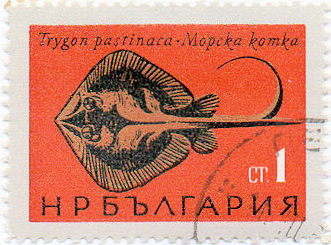
|
Data: 10/06/1965
Emissione: Ittiofauna Stato: Bulgaria |
|---|
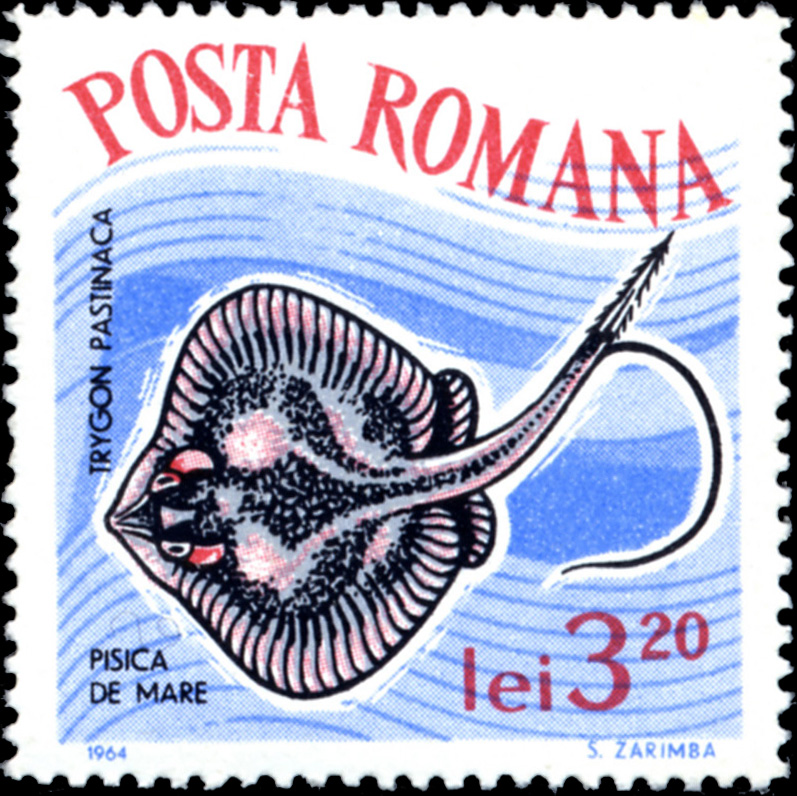
|
Data: 10/05/1964
Emissione: Ittiofauna Stato: Romania |
|---|
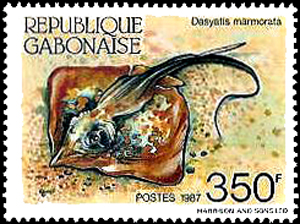
|
Stato: Gabon |
|---|
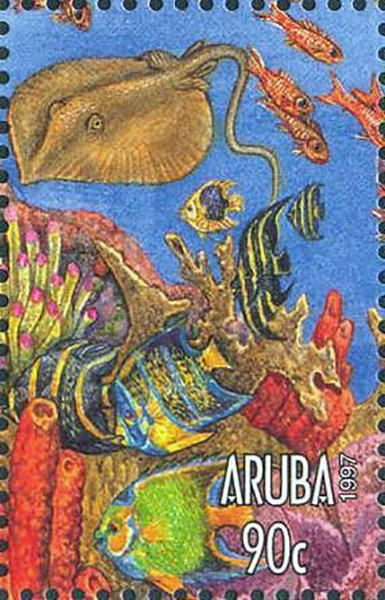
|
Data: 28/05/1997
Emissione: Vita marina Stato: Aruba |
|---|
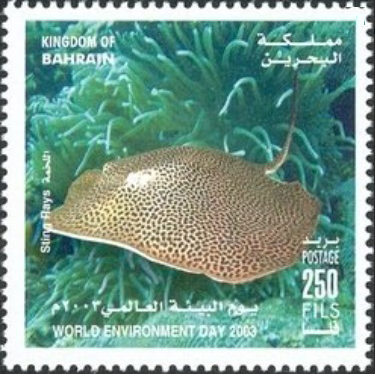
|
Data: 05/06/2003
Emissione: Giornata dell'ambiente Stato: Bahrain Nota: Emesso in un foglietto di 12 v. diversi |
|---|
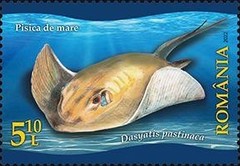
|
Data: 29/04/2022
Emissione: Fauna protetta del Mar Nero Stato: Romania Nota: Emesso in una serie di 4 valori diversi in un foglietto di 4 v. diversi |
|---|